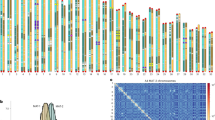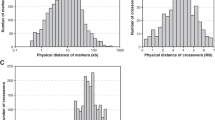Abstract
Ancient asexuals directly contradict the evolutionary theories that explain why organisms should evolve a sexual life history1,2. The mutualistic, arbuscular mycorrhizal fungi are thought to have been asexual for approximately 400 million years3,4. In the absence of sex, highly divergent descendants of formerly allelic nucleotide sequences are thought to evolve in a genome2. In mycorrhizal fungi, where individual offspring receive hundreds of nuclei from the parent, it has been hypothesized that a population of genetically different nuclei should evolve within one individual5,6. Here we use DNA–DNA fluorescent in situ hybridization to show that genetically different nuclei co-exist in individual arbuscular mycorrhizal fungi. We also show that the population genetics techniques4 used in other organisms are unsuitable for detecting recombination because the assumptions and underlying processes do not fit the fungal genomic structure shown here. Instead we used a phylogenetic approach to show that the within-individual genetic variation that occurs in arbuscular mycorrhizal fungi probably evolved through accumulation of mutations in an essentially clonal genome, with some infrequent recombination events. We conclude that mycorrhizal fungi have evolved to be multi-genomic.
This is a preview of subscription content, access via your institution
Access options
Subscribe to this journal
Receive 51 print issues and online access
$199.00 per year
only $3.90 per issue
Buy this article
- Purchase on Springer Link
- Instant access to full article PDF
Prices may be subject to local taxes which are calculated during checkout



Similar content being viewed by others
References
Maynard Smith, J. Contemplating life without sex. Nature 324, 300–301 (1986).
Welch, D. M. & Meselson, M. Evidence for the evolution of bdelloid rotifers without sexual reproduction or genetic exchange. Science 288, 1211–1215 (2000).
Judson, O. P. & Normark, B. B. Ancient asexual scandals. Trends Ecol. Evol. 11, 41–46 (1996).
Rosendahl, S. & Taylor, J. W. Development of multiple genetic markers for studies of genetic variation in arbuscular mycorrhizal fungi using AFLP. Mol. Ecol. 6, 821–829 (1997).
Sanders, I. R., Clapp, J. P. & Wiemken, A. The genetic diversity of arbuscular mycorrhizal fungi in natural ecosystems: A key to understanding the ecology and functioning of the mycorrhizal symbiosis. New Phytol. 133, 123–134 (1996).
Sanders, I. R. No sex, we're fungi. Nature 399, 737–739 (1999).
Smith, S. E. & Read, D. J. The Mycorrhizal Symbiosis (Academic, Oxford, 1997).
Van der Heijden, M. G. A. et al. Mycorrhizal fungal diversity determines plant biodiversity, ecosystem variability and productivity. Nature 396, 69–72 (1998).
Sanders, I. R. et al. Identification of ribosomal DNA polymorphisms among and within spores of the Glomales: application to studies of genetic diversity of arbuscular mycorrhizal fungal communities. New Phytol. 130, 419–427 (1995).
Lloyd-MacGilp, S. A. et al. Diversity of the ribosomal internal transcribed spacers within and among isolates of Glomus mosseae and related mycorrhizal fungi. New Phytol. 133, 103–111 (1996).
Redecker, D., Thierfelder, H., Walker, C. & Werner, D. Restriction analysis of PCR-amplified internal transcribed spacers of ribosomal DNA as a tool for species identification in different genera in the order glomales. Appl. Environ. Microbiol. 63, 1756–1761 (1997).
Lanfranco, L., Delpero, M. & Bonfante, P. Intrasporal variability of ribosomal sequences in the endomycorrhizal fungus Gigaspora margarita. Mol. Ecol. 8, 37–45 (1999).
Hoelzel, A. R. & Dover, G. A. Molecular Genetic Ecology 1–20 (IRL, Oxford, 1991).
Hijri, M., Hosny, M., van Tuinen, D. & Dulieu, H. Intraspecific ITS polymorphism in Scutellospora castanea (Glomales, Zygomycota) is structured within multinucleate spores. Fungal Genet. Biol. 26, 141–151 (1999).
Redecker, D., Hijri, M., Dulieu, H. & Sanders, I. R. Phylogenetic analysis of a dataset of fungal 5.8S rDNA sequences shows that highly divergent copies of Internal Transcribed Spacers reported from Scutellospora castanea are of Ascomycete origin. Fungal Genet. Biol. 28, 238–244 (1999).
Maynard Smith, J. et al. How clonal are bacteria? Proc. Natl Acad. Sci. USA 90, 4384–4388 (1993).
Mes, T. H. M. Character compatibility of molecular markers to distinguish asexual and sexual reproduction. Mol. Ecol. 7, 1719–1727 (1998).
Clapp, J. P., Rodriguez, A. & Dodd, J. C. Inter- and intra-isolate rRNA large subunit variation in Glomus coronatum spores. New Phytol. 149, 539–554 (2001).
van Gemeren, I. A. et al. The ER chaperone encoding bipA gene of black Aspergilli is induced by heat shock and unfolded proteins. Gene 198, 43–52 (1997).
Moran, N. A. & Wenegreen, J. J. Lifestyle evolution in symbiotic bacteria: Insights from genomics. Trends Ecol. Evol. 15, 321–326 (2000).
Giovannetti, M., Azzolini, D. & Citernesi, A. S. Anastomosis formation and nuclear and protoplasmic exchange in arbuscular mycorrhizal fungi. Appl. Environ. Microbiol. 65, 5571–5575 (1999).
Giovannetti, M. et al. The occurrence of anastomosis formation and nuclear exchange in intact arbuscular mycorrhizal networks. New Phytol. 151, 717–724 (2001).
White, T. J., Bruns, T., Lee, S. & Taylor, J. in PCR Protocols: A Guide to Methods and Applications (eds Innes, M. A., Gelfand, D. H., Sninsky, J. J. & White, T. J.) 315–322 (Academic, New York, 1990).
Antoniolli, Z. I., Schachtman, D. P., Ophel-Keller, K. & Smith, S. E. Variation in rDNA ITS sequences in Glomus mosseae and Gigaspora margarita spores from permanent pasture. Myc. Res. 104, 708–715 (2000).
Acknowledgements
We thank T. Boller and A. Wiemken for allowing part of this work to be conducted in the Botanical Institute Basle, T. Mes and M. Wilkinson for advice on the analysis, A. Rodriguez and J. P. Clapp for providing 28S sequences, E. Stöckli and H. Reichert for use of the confocal microscope, P. Heslop-Harrison for advice on in situ controls and J. P. Clapp, M. G. A. van der Heijden, L. Keller, A. M. Koch and F. Mery for critically reading the manuscript. We thank the Swiss National Science Foundation for supporting this work with a standard research grant and a fellowship awarded to I.R.S. under the professorial fellowship programme.
Author information
Authors and Affiliations
Corresponding author
Supplementary information
Rights and permissions
About this article
Cite this article
Kuhn, G., Hijri, M. & Sanders, I. Evidence for the evolution of multiple genomes in arbuscular mycorrhizal fungi. Nature 414, 745–748 (2001). https://doi.org/10.1038/414745a
Received:
Accepted:
Issue Date:
DOI: https://doi.org/10.1038/414745a
This article is cited by
-
Arbuscular mycorrhizal fungi heterokaryons have two nuclear populations with distinct roles in host–plant interactions
Nature Microbiology (2023)
-
Coexistence of genetically different Rhizophagus irregularis isolates induces genes involved in a putative fungal mating response
The ISME Journal (2020)
-
Evolutionary history and genetic diversity study of heat-shock protein 60 of Rhizophagus irregularis
Journal of Genetics (2019)
-
Evidence of non-tandemly repeated rDNAs and their intragenomic heterogeneity in Rhizophagus irregularis
Communications Biology (2018)
Comments
By submitting a comment you agree to abide by our Terms and Community Guidelines. If you find something abusive or that does not comply with our terms or guidelines please flag it as inappropriate.



